Team communication is among the most crucial aspects of collaboration, especially when working remotely, as it maintains strong, lasting working relationships at all organizational levels. Workplace communication studies show that 85% of company leaders cite employee communication and engagement as top priorities, yet only one-third have made it one.
So, what’s the solution to this communication barrier, and why is team communication important in the remote workspace today? This guide explores why team communication is important and some of the best practices for maintaining effective communication with remote teams.
7 Benefits of Effective Team Communication
Why is team communication important in remote workspaces? Here are several reasons.
1. Healthier Workplace Dynamics
In any organization’s culture, it’s important to connect with employees, especially those working remotely. Open and transparent verbal communication builds healthy and stronger relationships, allowing employees to remain productive.
Studies show that happier employees are 18% more productive. When team members are offered a space where they can freely share their ideas, thoughts, and concerns, it paves the way for stronger team collaboration, which builds stronger relationships.
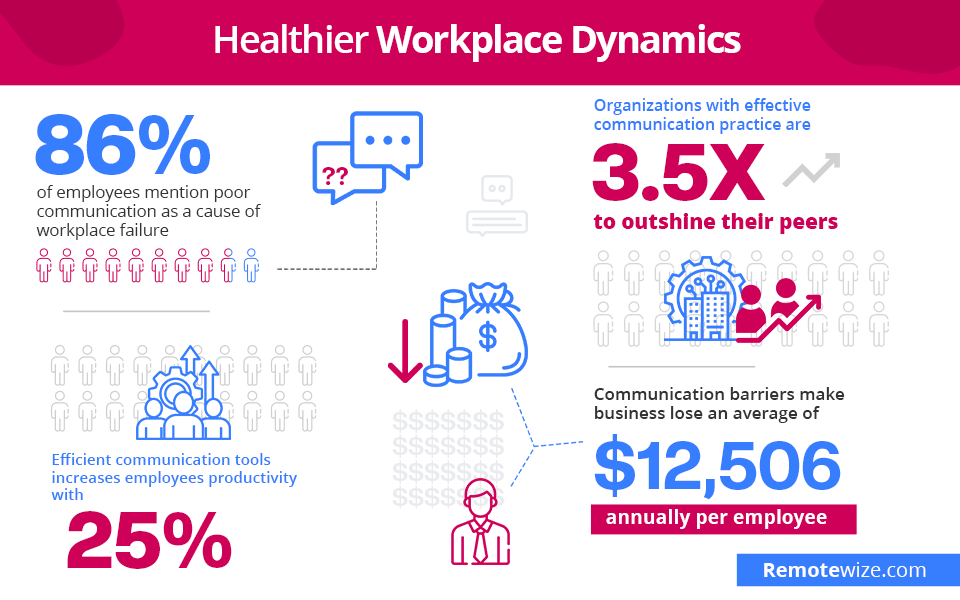
To achieve this, companies should take advantage of digital communication tools, such as Zoom and Google Meet, to keep the team connected at all times.
2. Elevated Team Engagement
About 85% of workers are not engaged at work, and half of them simply go through every day with a negative view of their workplace. Disengaged employees can cost the global economy as much as $8.8 trillion in lost productivity, according to Gallup’s State of the Global Workplace 2023 Report.
Among the factors that cause this issue is poor communication or a lack of communication within the team. In fact, 28% of employees cite poor communication as the key reason for not delivering their work on time, while 97% believe that poor communication affects their task delivery daily.
When employees feel seen, heard, and cared for, they are more likely to remain engaged. As such, company leaders should pay attention to workers, especially those working in remote and hybrid spaces, as they tend to feel more disengaged.
The most effective way company leaders can offer support to their teams is by prioritizing close collaboration. By providing a single source of truth and agreeing on which channel through which information is relayed, businesses can avoid confusion and boost employee engagement.
3. Enhanced Collaboration and Productivity
The ability to promptly message employees through project management tools solves problems quickly, ensuring tasks are completed on time. It’s also an effective way to ensure employees feel more connected, which helps improve employee productivity.
In fact, a study from the McKinsey Institute on the future of remote work indicates that employees who feel included in workplace communication are almost five times more likely to report increased productivity.
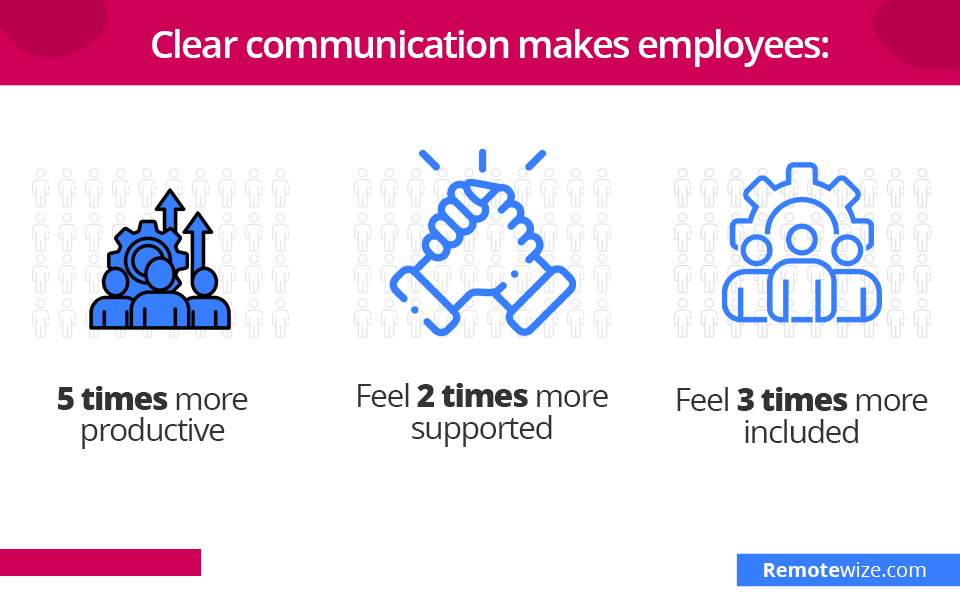
Good communication skills help remote teams collaborate, brainstorm, and discuss critical ideas, enabling personal and organizational development and growth.
4. Better Team Innovation
According to a Microsoft report, Work Trend Index 2023, 64% of employees say they have difficulty finding the time and energy to perform their jobs. Consequently, this group is also 3.5 times more likely to need help with creativity and innovation.
A work culture that fosters team communication stimulates innovation and strategic thinking. Employees who feel comfortable sharing their thoughts and ideas are more likely to collaborate and develop innovative solutions for different problems. Similarly, regular team communication cultivates a sense of unity, allowing employees to work hard toward achieving the company’s goals.
5. Improved Employee Wellbeing
Since the COVID-19 pandemic, most of the global workforce has shifted to a remote or hybrid work culture. This sudden change has transformed team dynamics, as most employees cannot interact as often as before, resulting in stress and anxiety.
Employees’ productivity can drop significantly when they are not physically and psychologically well or feel disconnected from their colleagues and supervisors.
A Gallup study showed that 49% of employees believed that their organization cared about their well-being in 2020, which had since decreased to 24% by November 2023.
When team members feel undervalued, especially in remote workspaces, they may be unable to fulfill their responsibilities, resulting in low productivity and often poor outputs. On the other hand, when employees maintain open communication and share their experiences, it keeps them emotionally healthy, which improves their well-being.
6. Increased Clarity and Transparency
Healthy team communication means that expectations are conveyed clearly, and no one is left guessing what they have to do to accomplish their goals in their position. Employees value dependable team leaders at dependable team leaders at 52%, honesty at 34%, and leaders who provide helpful and constructive feedback at 25%.
Workplaces surrounded by secrets and hidden information often lead to confusion and can prevent progress. On the other hand, transparency allows every team member to communicate effectively, share ideas, provide helpful feedback, solve problems, and ultimately build strong relationships.
7. Reduced Conflicts
Workplace conflict is no different from any other type of conflict. It can lead to tension, affecting not only the team members involved but also the whole team’s morale and engagement. For instance, in the UK, nearly 25% of employees have experienced workplace interpersonal conflicts in the past year.
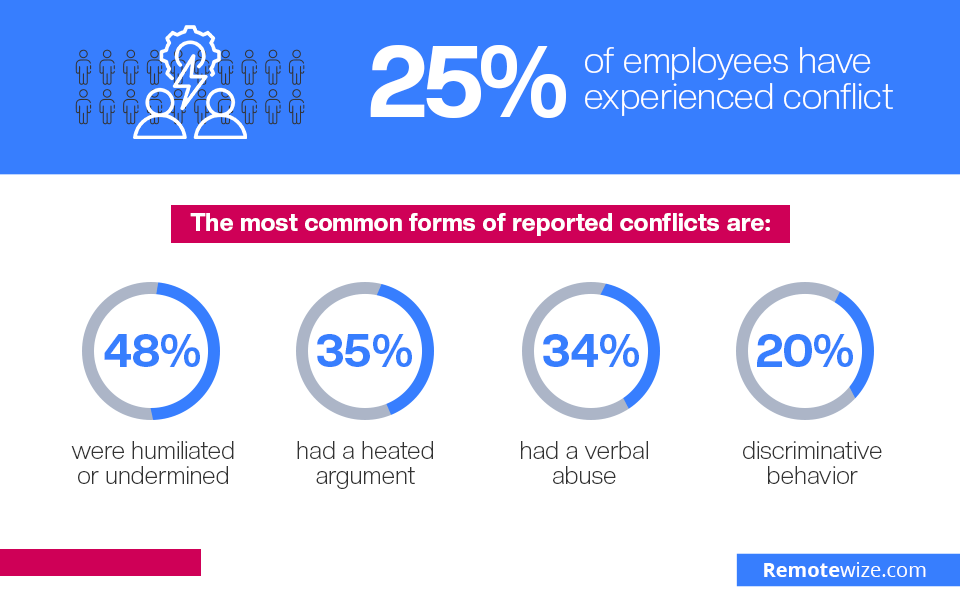
Conflicts are even more common in remote work environments, where face-to-face interactions are minimal. Miscommunication, interpersonal clashes, or differences in work styles are common issues that can lead to internal and external friction. When unresolved, these can decrease morale, derail tasks, and prevent creativity.
To prevent friction in the workplace, especially among remote teams, team leaders can formulate communication policies that address business communication needs and track progress to help reduce assumptions and promote collaboration.
If conflicts arise, have open discussions with the members and find mutually acceptable solutions to the problems. Methods such as seeking to comprehend behavioral motives, managing biases, and delegating conflict resolution can be used to mitigate conflicts.
Remote Team Communication Best Practices
A well-thought-out strategy is key to building a reliable employee communication system. To ensure that your team’s remote communication model isn’t a guessing game, we will explore some of the best ways to communicate with employees.
1. Choose Effective Communication Styles and Methods
Thanks to technological advancements, there is an entire suite of tools designed to improve team communication in a remote work environment. Email and G-chat might have worked while your team was in the office, but you will likely need to make some shifts and adopt more advanced communication modes now that everyone is working remotely.
Close to 72% of business leaders say that clear communication has improved their team’s productivity. To achieve this, team leaders should incorporate personalized emails and instant messaging for improved message delivery and better organizational engagement. Also, they should take advantage of video conferencing to achieve real-time interaction with every team member.
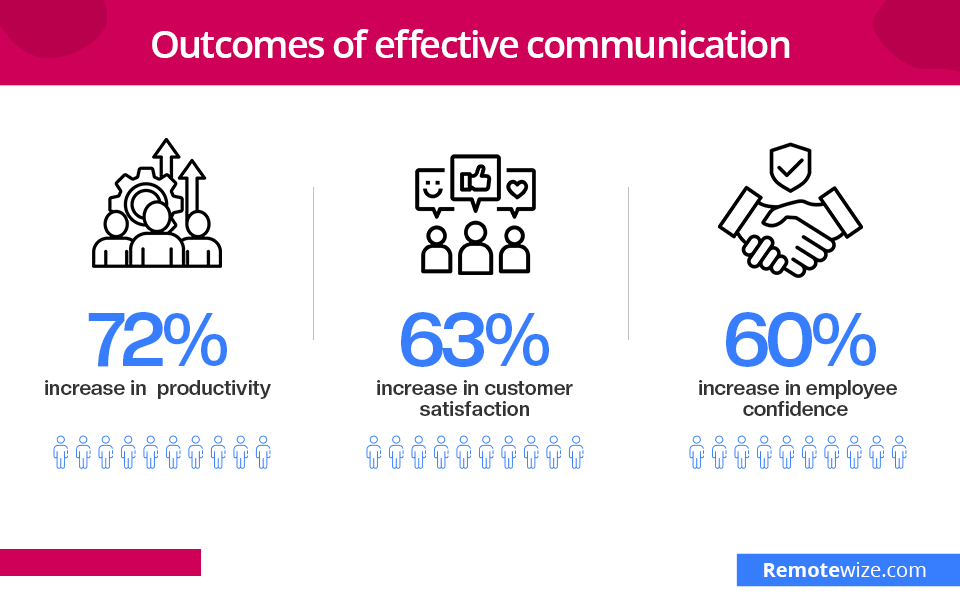
To find out which type of communication methods will be effective, leaders need to consider some key aspects such as:
- Which kind of meetings can be conducted via email?
- When are video calls necessary?
- Should the team share screens or use a common dashboard?
These points will allow them to narrow down and choose the best communication styles and techniques to help your team stay productive.
2. Leverage the Right Remote Team Communication Tools
The foundation for strong communication among remote teams lies in the type of communication channel used for video calls, messaging, and file sharing. Reliable solutions like Slack, Trello, Zoom, and Microsoft Teams have become essential, providing a unified space for real-time interactions.
About 60% of employees feel that they waste a lot of time in company meetings and are not fully engaged in them. After all, extended calls can eat into the time that employees could otherwise spend on problem-solving, more demanding tasks, or delivering key business results. When meetings become longer than expected, they can drain the teams’ energy and reduce their overall productivity.
When a team has a strong communication culture, they feel empowered to collaborate more effectively and deliver on the business goals. This explains the importance of leveraging the right communication tools to encourage effective communication and also enhance a productive remote environment.
3. Maintain Open Lines of Communication
In addition to having the right tools for effective communication, employers and employees must understand when to communicate. Close to 86% of employees, team leaders, and employers believe that poor communication is the key reason for workplace failures.
Similarly, about 80% of employees agree that poor and ineffective communication in the workplace makes them feel stressed, causing them to underperform by 5%.
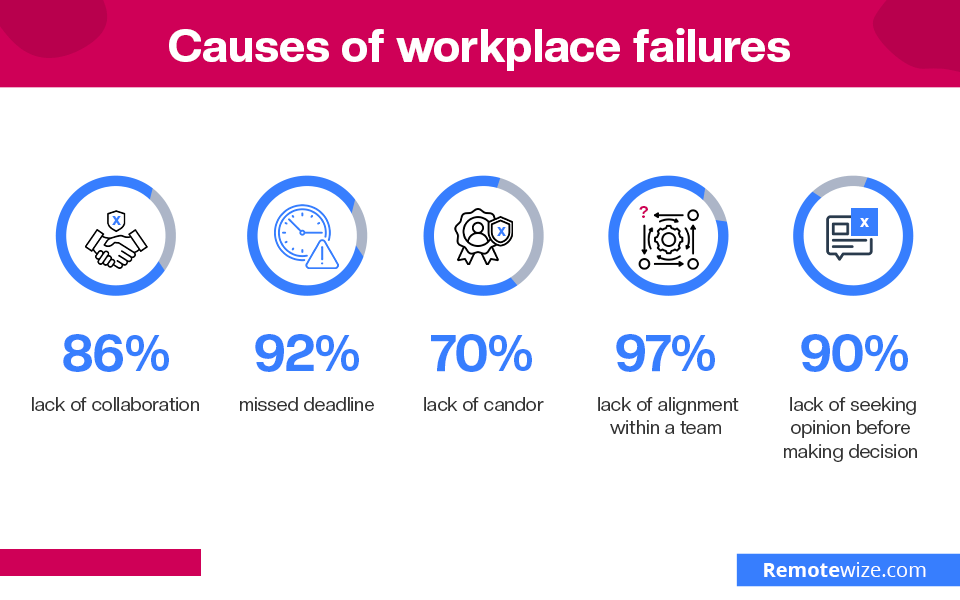
Managers need to select a communication platform, such as Slack, Zoom, or email, that works for everyone in the organization, no matter their position. Similarly, they shouldn’t wait until there is a misunderstanding to schedule a team meeting. Instead, plan regular meetings to ensure everyone is on track.
Also, the space should be transparent so that both parties can voice their opinions and concerns more frequently. Provide status updates and ensure all initiatives are communicated clearly. About 85% of workers agree that they feel motivated when management offers regular updates about the company.
4. Maintain a Professional Tone
Professionalism is required in the workplace. However, it can be hard to read a person’s tone, especially in virtual settings.
To get the most out of your remote employees, maintain a respectful and professional tone to convey the message positively. Incorporate some tips such as:
- Be punctual in virtual meetings and avoid keeping your participants waiting.
- Maintain a smile while you’re talking.
- Stay engaged during meetings by focusing on the screen, asking questions, and contributing to the discussion.
- Avoid interrupting others and wait for your turn to speak.
- Thank every team member for participating in the meeting, and send a summary or action points to everyone afterward.
5. Do Regular Check-Ins
Employee check-ins are a great way for team leaders to understand their employees’ challenges better and possibly provide solutions.
A weekly employee check-in is a great start. Ensure the employees are comfortable sharing their honest feelings, and be on the lookout for helpful resources to help them finish their tasks more efficiently. Ask them to provide as many details as possible about a typical working day and what challenges they might be facing.
The idea is not to make them feel monitored but to reinforce the benefits of driving impact and delivering performance standards in their work.
Make The Most of Effective Remote Team Communication
In the past year, many businesses have slowly been abandoning remote work setups to help revive employee engagement. In fact, 61% of U.S. companies have implemented formal policies that require employees to work on-site for a minimum number of days per week. However, it seems that remote working is not going anywhere, considering 53% of employees who are currently working from home say they would rather switch jobs if their employer issues a full-time return-to-office policy.
This begs the question: Is your organization prepared with the right tools and strategies to ensure effective team communication? Well, these tips above will help you and your team continue to communicate and collaborate despite unusual work settings. Focus on making every communication session interactive, invest in the right tools, plan well, and include every person in the process.
Why Effective Team Communication Is Important: FAQs
What are the effects of poor team communication?
Poor team communication may lead to increased errors, workplace conflicts, and low employee morale and engagement, potentially leading to missed deadlines and project delays.
What strategies would you use to address communication challenges in managing remote teams?
For remote teams, challenges will always arise. Whether it’s miscommunication, interpersonal clashes, or differences in working styles, issues will often emerge. However, you can easily prevent them from escalating with a solid plan. Arrange regular check-ins, set guidelines, be proactive during meetings, ensure everyone is on board with the right communication tools, and most importantly, create a safe environment where every team member can speak up.
Which tools are mostly used for remote communication?
Remote teams use a range of digital communication tools to complete their tasks and stay in touch with other team members. Slack is a great all-in-one team collaboration tool, while Microsoft Teams and Zoom can meet all video conferencing needs. Asana and Trello work perfectly for project management. But in the end, the best communication tool comes down to what works to fulfill your remote team’s needs.
How can teams improve their communication skills?
Teams can improve communication by conducting regular check-ins, using collaborative tools, encouraging two-way feedback, using clear language, and actively listening to each other.




